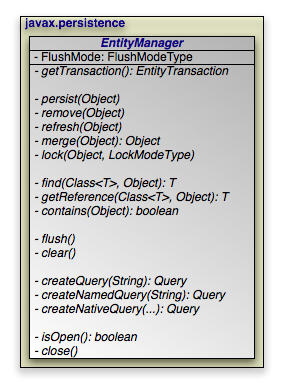
The diagram above presents an overview of the
EntityManager interface. For a complete
treatment of the EntityManager API, see the
Javadoc documentation. Methods whose parameter signatures consist
of an ellipsis (...) are overloaded to take multiple parameter types.
![[Note]](img/note.gif) | Note |
|---|---|
Kodo extends the standard |
The EntityManager is the primary interface
used by application developers to interact with the EJB persistence runtime.
The methods of the EntityManager can be
divided into the following functional categories:
TransactionassociationEntity lifecycle management
Entity identity management
Cache management
QueryfactoryClosing
public EntityTransaction getTransaction ();
Every EntityManager has a one-to-one
relation with an
EntityTransaction instance. In
fact, many vendors use a single class to implement both
the EntityManager and
EntityTransaction interfaces. If your
application requires multiple concurrent transactions, you will
use multiple EntityManagers.
You can retrieve the EntityTransaction
associated with an EntityManager through the
getTransaction method. Note that
most EJB persistence implementations can integrate with an application
server's managed transactions. If you take advantage of this feature,
you will control transactions by declarative demarcation or through
the Java Transaction API (JTA) rather than through the
EntityTransaction.